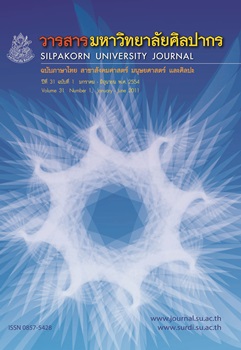การศึกษาและออกแบบผนังโฟมสำเร็จรูปที่ใช้เป็นแบบหล่อคอนกรีตได้ในตัวเพื่อใช้ใน การก่อสร้างบ้านประหยัดพลังงานและเพื่อการผลิตทางอุตสาหกรรม A Study and Design of Insulating Concrete Forms for Energy Efficient House Construction and Industrialized Production
Main Article Content
Abstract
บทคัดย่อ
งานวิจัยนี้มีวัตถุประสงค์เพื่อศึกษาและออกแบบผนังโฟมสำเร็จรูปที่ใช้เป็นแบบหล่อคอนกรีตได้ในตัว หรือICF (Insulating concrete forms) และประยุกต์ระบบการก่อสร้างขึ้นใช้สำหรับอาคารพักอาศัยในประเทศไทย ในการศึกษาได้ออกแบบผนัง ICF และทดสอบคุณสมบัติเชิงกลของผนัง ศึกษาสูตรและคุณสมบัติของโฟม PVC (Poly vinylchloride) ที่อาจใช้แทนโฟม EPS (Expanded poly styrene) เพื่อการผลิตผนัง ICF ออกแบบบ้านต้นแบบขึ้น 2 หลังโดยใช้ชิ้นส่วนผนังและระบบการก่อสร้างที่ออกแบบขึ้น คำนวณโครงสร้างอาคาร และประมาณราคาค่าก่อสร้างบ้านแล้วจึงวิเคราะห์ค่าพลังงานไฟฟ้าที่ใช้ของบ้านทั้ง 2 หลังเปรียบเทียบกับบ้านทั่วไป โดยใช้โปรแกรม EnergyPlusผนัง ICF ที่ออกแบบขึ้นใช้เป็นแบบหล่อสำเร็จรูป (Panel system) มีขนาดแผ่นมาตรฐาน 1.20 X 1.20 X0.18 เมตร (ความกว้าง x ความสูง x ความหนา) และมีช่องกลวงอยู่ภายในสำหรับใช้เ้ทคอนกรีต (โครงสร้า้ง) ผลิตขึ้นจากโฟม EPS และใช้กระเบื้องซีเมนต์เส้นใยแผ่นเรียบบุเป็นวัสดุผิวสำเร็จทั้งสองด้าน ผลการทดลองสูตรโฟม PVCพบว่าสามารถต้านทานแรงอัดได้ดี แต่ยังมีค่าความหนาแน่นสูง และการใช้หัวขึ้นรูปแบบปลายเปิดที่มีใช้อยู่ในห้องปฏิบัติการ ไม่สามารถขึ้นรูปหรือจัดรูปของชิ้นงานโฟมให้มีรูปร่างที่แน่นอนได้ ส่วนผลการประมาณราคาค่าก่อสร้างเฉลี่ยของบ้าน ICF ชั้นเดียว และบ้าน ICF สองชั้นที่ออกแบบขึ้น พบว่ามีราคาสูงกว่าของบ้านทั่วไป 1.9% และ 7.6% ตามลำดับ และผลการวิเคราะห์พลังงาน พบว่าในกรณีที่เปิดเครื่องปรับอากาศในช่วงกลางคืนเป็นส่วนใหญ่ บ้าน ICFชั้นเดียวและบ้าน ICF สองชั้น จะช่วยประหยัดพลังงานไฟฟ้าต่อปีได้ 7.4% และ 5.9% ตามลำดับ
คำสำคัญ : 1. ผนังโฟม. 2. ระบบการก่อสร้างบ้าน 3. บ้านประหยัดพลังงาน. 4. ผนังเบา. 5. แบบหล่อผนังคอนกรีต.
Abstract
The objectives of this research are to study and design an Insulated Concrete Form (ICF) and to applythis ICF component system to housing construction in Thailand. In the study, the prototype ICF panel wasdesigned and its mechanical properties were tested. The properties and formula of PVC foam were testedin order to determine whether it could be utilized to replace EPS foam. Two ICF model houses were designedusing the ICF components and construction system developed in the study. The structural calculation,working drawings, and construction cost estimation of two ICF model houses were carried out. Energyconsumption and electricity costs of ICF model houses were studied through the use of a computer program(EnergyPlus) and compared with conventional houses.The developed ICF system is a “Panel System” which has concrete structures inside the ICF wall.The standard size of the ICF wall prototype is 1.20 x 1.20 x 0.18 m. (width x height x thickness). ICFconcrete forms are made of EPS foam finished with fiber cement boards on both sides. The developed PVCfoam has high compressive strength but its density is quite high. The costs of the ICF one-storey house andthe ICF two-storey house are 1.9% and 7.6% higher than the cost of the conventional ones, respectively. Inthe case of operating air conditioning mainly at night, the ICF one-storey house and ICF two-storey housesreduce electrical energy consumption by 7.4% and 5.9% respectively.
Keywords: 1. Foam core panel. 2. Housing construction system. 3. Lightweight panel.4. Insulating concrete form


